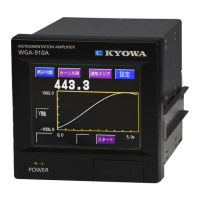
Do you have a question about the KYOWA WGA-910A Series and is the answer not in the manual?
| Rated Output Voltage | ±10 V |
|---|---|
| Frequency Response | DC to 100 kHz |
| Input Impedance | 1 MΩ |
| Power Supply | ±15V DC |
| Input Voltage Range | ±10 V |
| Operating Temperature Range | 0 to 50°C |
| Gain Range | 1 to 1000 |
| Common Mode Rejection Ratio | 80dB |
| Noise | 5μVrms |
| Weight | 300g |
Explains safety symbols used in the manual to highlight potential hazards.
Ensures correct power supply voltage and connection to prevent fire hazards.
Details safe practices for connecting power cables and using grounding terminals.
Ensures proper grounding to prevent electric shock hazards.
Cautions operators against altering protective grounding conductors or disconnecting terminals.
Instructs to check protective ground function before operation for safety.
Ensures safe grounding of external instruments before connecting to the WGA-910A.
Explains fuse function and advises contacting KYOWA for replacements.
Warns against operating in environments with flammable gases, vapors, or dust.
Details immediate actions if smoke occurs from the WGA-910A.
Specifies limits for input voltage to prevent damage and performance degradation.
Provides safety instructions for handling the internal lithium battery.
Warns against using the product outdoors due to potential hazards and performance issues.
Advises waiting 5 seconds after power OFF before turning ON to prevent product damage.
Specifies the safe operating temperature range of -10 to +40°C.
Specifies the safe operating humidity range of 20 to 85% RH.
Recommends allowing the product to adapt to environmental changes to prevent condensation.
Warns against excessive vibration or impact which can degrade performance or cause failure.
Advises avoiding strong electromagnetic fields that may affect performance.
Covers power supply stability, noise, and avoiding cord strain.
Prohibits disassembly or remodeling to prevent electric shock or damage; voids warranty.
Warns against use or storage in dusty, particle-filled, or corrosive gas environments.
Warns against exposing the product to sea air which may cause performance issues.
Provides guidance on handling the CD-R to prevent damage or read errors.
Recommends preheating the product for approximately 30 minutes before use.
Details how to clean the product using a dry cloth or air blow gun.
Details installation, wiring, grounding, and environmental requirements for CE marking.
Explains how panel surface names are denoted in the manual.
Describes notations used to attract attention to special care or reference information.
Provides examples of how specific notations are presented in the manual.
Describes output behavior when the transducer cable is broken and advises countermeasures.
Specifies requirements for the output signal's unbalance load (5k ohm or more).
Provides a general description of the WGA-910A Instrumentation Amplifier.
Lists the main features, including high-speed sampling, multiple calibration functions, and SD card capability.
Identifies and describes the controls and displays on the front panel.
Details the 'Measuring Window' when displaying numerical values.
Details the pin assignment and function of the RS-232C connector.
Specifies the protective grounding terminal for safety.
Describes the metal fitting used for panel mounting.
Details the terminal board for monitor output and its function.
Outlines the sequence of operations required before taking measurements.
Details how to connect strain gage transducers to the input connector.
Provides instructions for inserting an SD card into the WGA-910A.
Provides instructions for safely removing the SD card from the WGA-910A.
Illustrates the hierarchical structure of the WGA-910A's settings menu.
Explains the procedure and conditions for saving waveform data to the SD card.
Introduces the four calibration methods available: manual, TEDS auto, TEDS part, and numeric.
Explains how to navigate to the calibration window from the measuring screen.
Details the steps for manual calibration, starting with bridge voltage and no-load zero.
Refers to Section 5 for detailed calibration methods like manual and TEDS.
Explains how to set the current display value to zero using key operation or external input.
Allows selecting whether to conduct or prohibit no-load zero during TEDS reading.
Explains how to read and display TEDS information on the window.
Explains smoothing using analog or digital methods to stabilize display values.
Automatically sets the display to zero within compensation range at set intervals.
Explains how to select measuring conditions via key operation, control input, or command.
Sets the width between comparator ON and OFF states to prevent chattering.
Illustrates how comparator outputs and status lamps behave with hysteresis.
Configures the end point of the time axis (X-axis) for waveform display.
Sets the signal used for selecting the measuring condition number.
Allows locking or releasing the keys to prevent accidental changes.
Checks the ROM, RAM, and EEPROM for faults to ensure memory integrity.
Checks display color changes and backlight operation.
Verifies the responsiveness and functionality of the touch panel.
Saves all setting values, excluding calibration, to the SD card.
Reads setting values from the SD card and overwrites them on the WGA-910A.
Illustrates timing diagrams for HOLD, RESET, and ZERO commands.
Details waveform display and SD signal output timing in Single Mode.
Details the signaling system, data rate, parity, stop bit, and delimiter for RS-232C.
Explains the formats and types of control commands for external equipment.
Describes commands for initializing settings, performing RS line tests, and outputting model info.
Reads specific setting values such as calibration, smoothing, and comparator settings.
Sets the excitation voltage for the sensor (2V or 10V).
Executes the no-load zero function for the sensor.
Sets the communication speed (baud rate) for RS-232C and RS-485 interfaces.
Addresses issues where the unit does not power on, checking cables and fuses.
Lists common error messages and their potential causes and checks.
Recommends annual maintenance inspection for operation and accuracy.
Advises on replacing aluminum electrolytic capacitors and lithium batteries based on service life.
Lists detailed technical specifications for the WGA-910A instrument.
Compiles a list of all settable items for calibration and input settings.
